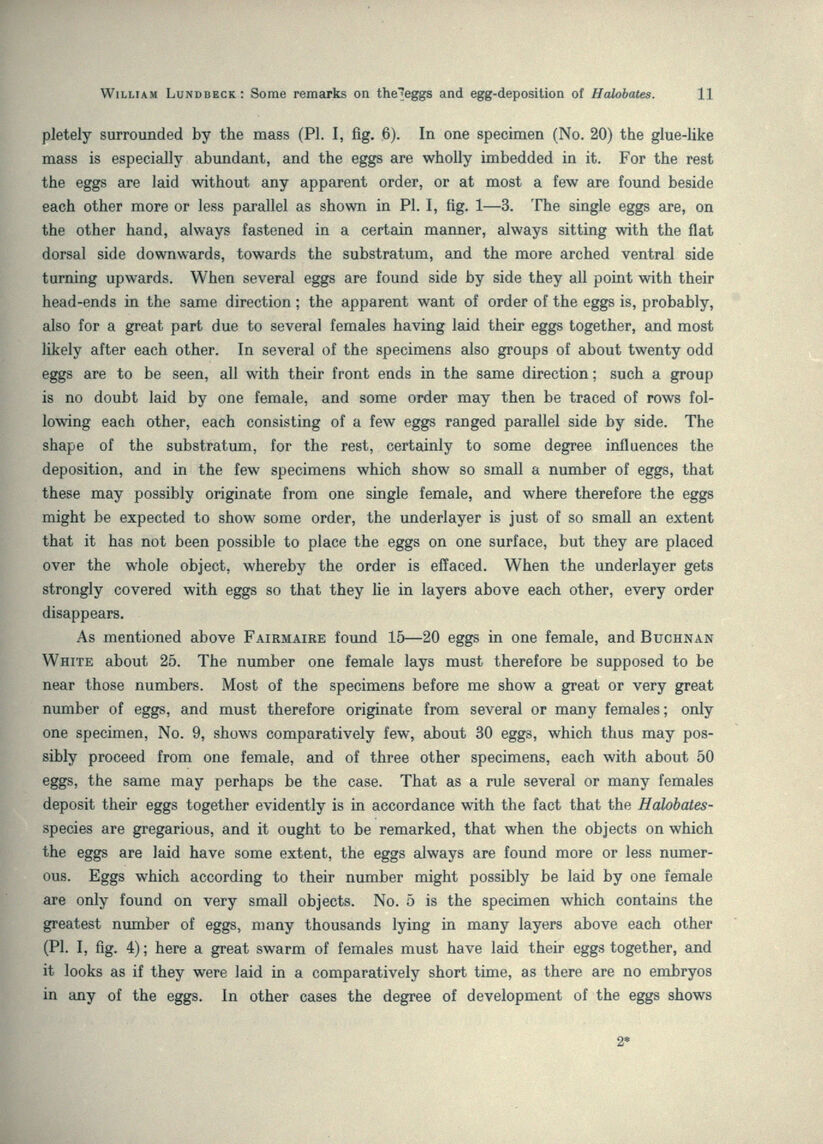
Full resolution (JPEG) - On this page / på denna sida - Some Remarks on the Eggs and Egg-deposition of Halobates

<< prev. page << föreg. sida << >> nästa sida >> next page >>
Below is the raw OCR text
from the above scanned image.
Do you see an error? Proofread the page now!
Här nedan syns maskintolkade texten från faksimilbilden ovan.
Ser du något fel? Korrekturläs sidan nu!
This page has been proofread at least once.
(diff)
(history)
Denna sida har korrekturlästs minst en gång.
(skillnad)
(historik)
completely surrounded by the mass (Pl. I, fig. 6). In one specimen (No. 20) the glue-like
mass is especially abundant, and the eggs are wholly imbedded in it. For the rest
the eggs are laid without any apparent order, or at most a few are found beside
each other more or less parallel as shown in Pl. I, fig. 1 — 3. The single eggs are, on
the other hand, always fastened in a certain manner, always sitting with the flat
dorsal side downwards, towards the substratum, and the more arched ventral side
turning upwards. When several eggs are found side by side they all point with their
head-ends in the same direction; the apparent want of order of the eggs is, probably,
also for a great part due to several females having laid their eggs together, and most
likely after each other. In several of the specimens also groups of about twenty odd
eggs are to be seen, all with their front ends in the same direction ; such a group
is no doubt laid by one female, and some order may then be traced of rows
following each other, each consisting of a few eggs ranged parallel side by side. The
shape of the substratum, for the rest, certainly to some degree influences the
deposition, and in the few specimens which show so small a number of eggs, that
these may possibly originate from one single female, and where therefore the eggs
might be expected to show some order, the underlayer is just of so small an extent
that it has not been possible to place the eggs on one surface, but they are placed
over the whole object, whereby the order is effaced. When the underlayer gets
strongly covered with eggs so that they lie in layers above each other, every order
disappears.
As mentioned above Fairmaire found 15 — 20 eggs in one female, and Buchnan
White about 25. The number one female lays must therefore be supposed to be
near those numbers. Most of the specimens before me show a great or very great
number of eggs, and must therefore originate from several or many females; only
one specimen, No. 9, shows comparatively few, about 30 eggs, which thus may
possibly proceed from one female, and of three other specimens, each with about 50
eggs, the same may perhaps be the case. That as a rule several or many females
deposit their eggs together evidently is in accordance with the fact that the Halobates-
species are gregarious, and it ought to be remarked, that when the objects on which
the eggs are laid have some extent, the eggs always are found more or less
numerous. Eggs which according to their number might possibly be laid by one female
are only found on very small objects. No. 5 is the specimen which contains the
greatest number of eggs, many thousands lying in many layers above each other
(Pl. I, fig. 4) ; here a great swarm of females must have laid their eggs together, and
it looks as if they were laid in a comparatively short time, as there are no embryos
in any of the eggs. In other cases the degree of development of the eggs shows
<< prev. page << föreg. sida << >> nästa sida >> next page >>